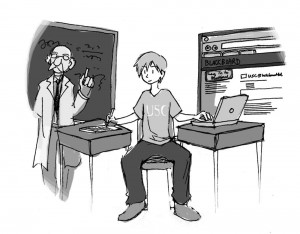Online education needs connection
From the most trivial of issues (who went to what party this weekend?) to the most traditional of society’s establishments (newspapers, music and book industries, Postal Service), Internet has transformed our lives. But one area remains to be revolutionized digitally: education.
Online education is on the rise, pitting those who support the idea of a virtual university for its ability to increase access and revenue against those who believe there is no substitute for real-time, traditional educational experiences.
There’s one thing wrong with the entire conversation, however: Viewing online education as a new higher education business model that must supplant the current system is a close-minded view. Why not look at it as a means by which we can strengthen and innovate education by blending digital and traditional elements?
Online education began mostly as distance-learning programs for graduate degrees that lend themselves to the medium like engineering or business.
USC’s Viterbi School of Engineering has a well-established Distance Education Network that offers more than 30 master’s degree programs.
Now, in times of financial crisis, schools across the country, especially in California, are searching for ways to reinvent themselves. This has led to an expansion of digital courses into the undergraduate sphere.
But there is a distinct danger in allowing finance-driven ideas to dominate the dialogue about schools’ futures and education in general, especially for undergraduates whose educational experiences and life tracks are so defined by their first four years on a campus.
This is not to say that universities should completely reject online learning. It’s great to be able to listen to lectures at home or gain access to classes you can’t physically attend or afford.
Higher learning, however, is about a level of personal interaction and commitment that can’t be recreated online.
Before transferring to USC, I spent a semester at the University of San Francisco, where I took a hybrid service-learning Spanish class. It combined conventional in-class instruction twice a week with a once-a-week class online with Blackboard, in addition to a requirement of outside community service hours.
This kind of blending shows the innovative potential universities should recognize and seize. The idea of a virtual university should not replace the traditional, but instead should merge with it.
For undergraduates, hybrid classes could be incredibly valuable and much more engaging for a generation that spends so much time online.
Some of the University of California schools have submitted courses in response to an online education pilot project proposed by the University’s Office of the President.
Sebastian Thrun, a professor at Stanford University renowned for leading the team that built Google’s self-driving car, now offers a free online course, “Introduction to Artificial Intelligence.” Enrollment in this class has jumped from 58,000 to 130,000 across the world in the past month, according to The New York Times. USC is lucky enough to have generous alumni that keep it more than afloat financially. But as many universities choose to go digital, USC might want to follow suit.
The potential of all things online is vast. And there’s no match for the value of real-time, person-to-person educational experiences.
There’s no reason universities can’t take advantage of both.
Elena Kadvany is a senior majoring in Spanish. Her column “Beyond the Classroom” runs Mondays.


Course Instructor Sebastian Thrun’s and Google’s Eric Schmidt’s reputations are built upon crimes, conspiracies and censorship of my speech to the public. Their cowardice reaction to my public challenge indicates they are guilty from inside their heart.
Before this case could be clarified, Course Instructor Sebastian Thrun’s name is not clear in these crimes which had cost human lives. Sebastian Thrun dare not deny anything I said.
When Eric Schmidt was in control of Google, he had abused google resource to support a criminal suspect Gabriele Scheler to cover up her crimes in name of Stanford Computer Science Department. and the complication from Gabriele Scheler’s case had get Stanford Computer Science professor Sebastian Thrun into Gabriele Scheler’s criminal case. Eric Schmidt had abused his power and google resources to support Gabriele Scheler’s false accusation of sexual assault on me and to support Sebastian Thrun’s unruly behaviors in Stanford, which had escaladed the complication in this case again and again, and which had led to Stanford student May Zhou’s death, a murder of an innocent Stanford student by Eric Schmidt,Sebasitan and Gabriele Scheler’s side; and later during their fight against ruling from U.S. authorities, Eric Schmidt, Sebastian Thrun and Gabriele Scheler’s side had plotted a murder on me as well. – See if they dare deny these facts in my public challenge here.
These unbelievable happenings are real and so far I am still waiting to see if Eric Schmidt and Sebastian Thrun could show facts to contradict my saying, or clearly deny any of my accusations against them, remember, those are crimes that had cost human life.